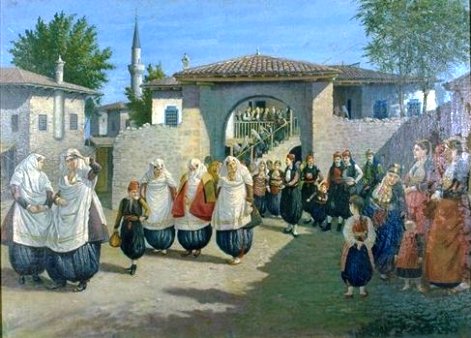Ottoman architecture in Albania occupies a very important place in the country's history and includes the time period between the 15th and 19th centuries. The range of buildings included not only religious buildings such as mosques, mosques, mosques, madrassas, but also public schools (schools), public canteens, hostels, bazaars, caravanserais, public baths, springs, tombs and tombs, bridges, fountains, palaces and towers. of hours According to the historian Ayverdi, the number of buildings that were built during the long period of stay in this country and that were registered exceeds the number of 1,015. It counts 9 forts, 482 Mosques, 28 Madrasahs, 111 Public Schools, 144 Teqee and Zaviye, 9 Public Kitchens, 123 Inns, 18 Public Baths, 38 Shrines, 18 Bridges and 13 Springs. Most of these buildings were built in cities that were at that time administrative centers of the Sanjak such as Krujë, Vlorë, Berat, Gjirokaster, Elbasan, Korce, Shkodër, Tepelën and Tirana. During the communist period, most of the Ottoman heritage in Albania was destroyed for ideological reasons.
Mosques:
- Two types of mosques in Albania: rectangular with traditional roofs, typical of the Balkans, and monumental style with harmoniously balanced volumes.
- Examples include King Mosque in Elbasan, Sultan II. Bayezıd Mosque, Fethiye Mosque, and Lead Mosque, each reflecting different architectural styles.
- Mosques offer insights into historical development, with Elbasan Castle showcasing remnants and ongoing archaeological investigations.
Tekkes:
- Bektashism is prevalent in Albania, with tekkes built outside city centers under various tarikats.
- Examples include Elbasan Sinan Pasha Tekke, Baba Ali Tekke, and Haydar Baba Mema Tekkesi, reflecting diverse architectural styles.
- Tekkes serve as centers for Bektashi worship, emphasizing residential architectural features.
Tombs (Turbe):
- Few surviving tombs in Albania, often built near mosques or dervish lodges, showcasing diverse architectural plans.
- Examples include Mustafa Baba Dolma Tekke and Tiran Nuses (Brides) Tomb, featuring different tomb shapes and plans.
- Square, rectangular, and octagonal-shaped tombs reveal the historical and architectural diversity in Albania.
Han, Bedesten, and Bazaars:
- Ottoman archives detail numerous khans and bazaars in Albania, though many are no longer extant.
- Surviving examples include Bedesten and Bazaar in Görice, Pazar Çarşısı in Akçahisar, and Market Bazaars in Shkodra.
- These structures offer insights into the vibrant commercial and cultural life of Ottoman-era centers.
Medrese and Mekteb:
- Medreses and mektebs integral to Ottoman-era Albania, often adjacent to mosques, emphasizing religious worship and education.
- Notable examples include Mehmet Pasha Bushati's medrese complex and Mektep Rusdiye Asqerije in Shkodra.
- The 19th century saw significant growth in educational institutions, with Turkish-language schools flourishing in various regions.
Fortress:
- Ottoman conquest led to strategic construction and refurbishment of fortresses across Albania.
- Elbasan Fortress, commissioned by Fatih Sultan Mehmet, exemplifies the strategic and administrative role of these structures.
- Gjirokaster, Berat, Lezhe, Janina, and Shkodra castles reflect a blend of ancient and Ottoman influences.
Public Bath (Hamam):
- Ottoman-era baths in Albania follow classical Ottoman design, featuring cold and hot sections.
- Two types: Single-Hamam and Couple-Hamam, serving different purposes, with Elbasan Bazaar Hamam being the largest in Albania.
- Hamams, though smaller in scale, play a significant role in reflecting Ottoman influence on Albanian architecture.
Clock Tower (Saat
Kulesi):
- Clock towers in major Albanian cities date from the Ottoman period, often located in city squares or castles.
- Paired with minaret-crowned mosques, clock towers serve as iconic landmarks defining urban landscapes.
- These structures symbolize the passage of time and contribute to the cultural and architectural identity of cities.
Fountains (Çeşmeler):
- Albania had numerous fountains during the Ottoman period, serving practical and aesthetic purposes.
- Enduring examples include Elbasanda Architect Mehmet Aga Fountain and Meçites Fountain in Gjirokastër.
- Fountains stand as architectural landmarks, contributing to the rich Ottoman heritage in Albania.
Bridges (Köprüler):
- Ottomans initiated bridge construction in Albania upon their arrival, with many located outside settlements along rivers.
- A significant number of bridges, with 143 identified, 86 belonging to the pre-Ottoman period.
- Bridges showcase Ottoman influence on Albanian infrastructure, especially in mountainous regions.


Comments
Post a Comment